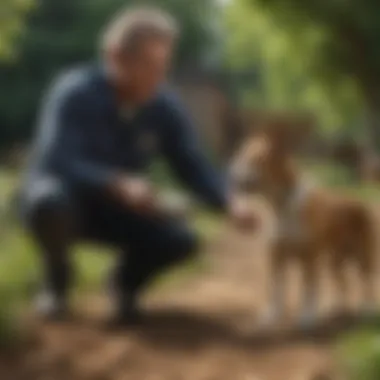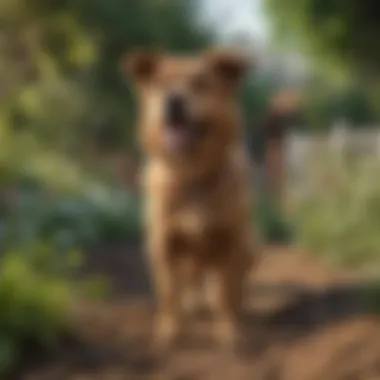Effective Strategies to Prevent Dog Digging


Overview of the Topic
Definition and Importance
Preventing dogs from digging in gardens is an important concern for many pet owners. Digging can lead to significant damage in gardens, affecting both the aesthetics and health of plants. It is particularly pertinent for agriculture farmers. Dogs have innate digging behaviors, influenced by various factors, such as boredom, instinct, or even a need to escape. Understanding these aspects can help owners address digging effectively and preserve garden integrity.
Current Trends
Recent trends in pet care focus on more holistic and training-focused approaches. Many dog owners are seeking advice from professionals on behavioral training. Additionally, there is an increased interest in creating environments that are enriching and engaging for dogs. This reflects a broader understanding of canine psychology and the significance of meeting a pet’s mental and physical needs. Ensuring a happy dog also means a well-maintained garden.
Key Techniques and Practices
Step-by-Step Guide
- Understand the Cause:
Observe your dog’s behavior. Determine if digging is a result of boredom, anxiety, or natural instincts. - Increase Exercise:
Dogs often dig due to excess energy. Regular walks or playtime can reduce this behavior. - Provide Alternatives:
Offer safe digging spaces, like a specific area filled with sand, where dogs can dig without harming the garden. - Train Commands:
Use commands like "leave it" or "no dig". Positive reinforcement will aid in reinforcing these commands. - Modify the Environment:
Plant dense shrubs or install barriers around more delicate areas in your garden.
Tools and Equipment Needed
- Fencing: Effective barriers can prevent access to certain garden sections.
- Digging Box: A designated box filled with sand or soil can attract dogs to dig in a suitable area.
- Training Treats: Positive reinforcement through treats is crucial for successful training.
Challenges and Solutions
Common Obstacles
Owners may face several challenges, such as a dog’s strong instincts or lack of attention to training. Another common issue is the misinterpretation of digging as a sign of misbehavior rather than a natural habit.
Innovative Solutions
- Enrichment Toys: Use toys that challenge a dog’s intellect, focusing their energy elsewhere.
- Interactive Games: Engage dogs in games that require them to dig safely, channeling their behaviors productively.
- Create Garden Zones: Dedicate areas of your garden for specific activities. For instance, area for dogs to run and fetch may take their attention away from sensitive plants.
Addressing digging behaviors in dogs is not just about reactive solutions but rather proactive engagement with your pet. The goal is to maintain both a beautiful garden and a fulfilled dog.
Understanding Dog Digging Behavior
Understanding why dogs dig is crucial for effectively managing this behavior in your garden. This section aims to highlight specific elements of canine instincts and behaviors that drive digging. Through understanding these motivations, gardeners can adopt strategies that align with their dogs’ needs while preserving the integrity of their landscape.
Recognizing digging as an instinctual behavior plays a central role. Dogs are naturally predisposed to digging, and assessing the underlying reasons helps determine appropriate measures for prevention. Ignoring these instincts can lead to frustration for both the pet and the owner. This understanding allows one to create an environment that caters to dogs' needs, reducing the likelihood of unwanted digging.
The Instinctual Nature of Dogs
Dogs, as descendants of wild canines, possess inherent instincts that drive their behaviors. Digging is one of these primal behaviors. Historically, dogs dug to create shelters or to search for food. Acknowledging this connection provides insight into why your pet may feel the need to dig in your garden.
Moreover, this behavior serves multiple functions. It can be a self-soothing mechanism for anxiety or a natural expression of playfulness. Understanding these motivations is essential for preventing digging in your garden and helps develop strategies that resonate with your dog's nature.
Common Reasons for Digging
Seeking Shelter
Many dogs dig to create a comfortable resting place. This action mimics the instinct to burrow into warm, safe spots. Understanding this behavior can lead to solutions such as providing suitable bedding. Awareness of the dog's comfort needs contributes to overall satisfaction, thereby reducing the urge to dig. Ensuring your dog has access to a sheltered area can balance their instinctual behavior with your gardening efforts.
Exploring Smells
Dogs experience the world primarily through their sense of smell. Digging can often emerge from a desire to explore interesting odors. This behavior showcases a dog's natural curiosity. When they encounter scents within the soil that pique their interest, it is common for them to dig. Recognizing this behavioral trait is vital. It may be helpful to provide alternative areas where they can safely explore different smells.


Boredom and Anxiety
Boredom and separation anxiety can significantly contribute to digging behaviors. Dogs left alone for extended periods may resort to digging out of frustration or stress. It's crucial to address the underlying causes rather than simply focusing on the digging itself. Implementing structured playtime or providing toys can alleviate boredom. Supporting your dog's emotional well-being is essential for reducing anxiety and consequently, digging.
Attention-Seeking Behavior
Dogs often dig to capture their owner's attention, whether it be positive or negative. This behavior highlights a dog's social needs and the importance of interaction. Recognizing attention-seeking digging can guide owners in redirecting this behavior through training and play. Rewarding appropriate behaviors can strengthen the bond between dog and owner and mitigate unwanted actions.
When Digging Becomes a Problem
When digging becomes destructive or frequent, it warrants immediate attention. A dog's instinctual behavior may turn into an issue that damages plants or disrupts garden aesthetics. Identifying the specific causes behind this problem is necessary. Each dog's motivations may vary, and an informed approach is essential for finding effective solutions.
Creating an environment that satisfies your dog’s needs while maintaining garden order is a delicate balance. By understanding digging behavior, you equip yourself with the knowledge necessary to foster a harmonious living space that accommodates both canine instincts and gardening endeavors.
Enhancing the Garden Environment
In preventing dogs from digging, a well-thought-out garden environment can play a crucial role. By understanding how alterations to your garden can influence your dog's behavior, you create a space that is not only aesthetically pleasing but also discourages unwanted digging. Ensuring that your garden accommodates your dog's instincts while providing boundaries can lead to a more harmonious coexistence.
Creating Designated Digging Areas
Creating specific zones for your dog to dig can effectively redirect their natural instincts. When setting up these designated areas, it is important to choose a location in the garden that is less likely to disrupt your plants while allowing your dog to satisfy their curiosity. This can be an area buried under loose soil or sand where digging is acceptable. By training your dog to use this zone, you give them an outlet for their digging behavior while protecting other parts of your garden.
Landscaping Choices That Deter Digging
Landscaping choices can significantly impact a dog's behavior regarding digging. The right plants and structure can keep a dog's interests diverted and encourage them to stay away from specific garden areas.
Selecting Low-Digging Plants
Selecting low-digging plants is a practical approach. Plants that are close to the ground or have a robust root system are less likely to encourage digging. This is beneficial because it minimizes the chances of a dog's curiosity leading them to uproot your flowers or vegetables. Using perennials and ground covers like creeping thyme or ornamental grasses can be effective. These plants do well in gardens and require minimal maintenance, making them a popular choice among gardeners. However, one should be mindful of certain aspects, such as whether the selected plants will thrive in the given environment and whether they are safe for dogs.
Using Raised Garden Beds
Using raised garden beds is another effective landscaping technique. This approach elevates your plants, making it more challenging for dogs to access them. The borders of raised beds act as a physical barrier. Additionally, this setup can enhance the aesthetic appeal of your garden. Raised beds can facilitate easier access for gardeners, simplifying maintenance tasks. However, they may require some adjustments to ensure they are secure and high enough to deter digging. The cost of constructing such beds can vary but typically is justified by the long-term benefits.
Incorporating these strategies effectively enhances the garden environment and reduces the likelihood of your dog digging in unwanted areas. A thoughtful garden design can lead to a beneficial relationship between your pet and your horticultural pursuits.
Training Techniques to Curb Digging
Training techniques are essential for preventing dogs from digging in gardens. These methods help modify your dog's behavior, ensuring they understand what is appropriate and what is not. Training creates a sense of structure for your pet, leading to a more harmonious environment for both the dog and its owner. It is much easier to manage a dog's digging tendencies when appropriate training techniques are applied consistently.
Positive Reinforcement Strategies
Using positive reinforcement is a widely recognized method for training dogs. This approach focuses on rewarding good behavior rather than punishing bad behavior. When dogs dig in an acceptable area or cease their digging, offering treats or praise can encourage this behavior in the future.
Reward Systems
Reward systems offer an effective way to motivate dogs during training sessions. The primary aspect of reward systems involves reinforcing desired behaviors with positive outcomes. Dogs naturally respond to rewards, making this method both easy and effective for pet owners. The key characteristic of reward systems is their basis in psychological principles that emphasize motivation through incentive.
Advantages of this system include creating a strong bond between the dog and owner. This bond can enhance overall obedience and make training more enjoyable. However, it's essential to carefully monitor the frequency and type of rewards given to avoid overindulgence, which may inadvertently encourage other unwanted behaviors.
Redirecting Behavior
Redirecting behavior is another powerful strategy in dog training. Rather than focusing solely on discouraging digging, owners can redirect their dogs to more appropriate activities. This technique is particularly useful when the dog is engaged in digging. The key characteristic here is the proactive approach taken to steer the dog's energy towards a more productive outcome.
Redirecting behavior is beneficial in that it keeps your dog stimulated and focused, rather than reprimanding them for undesirable actions. By engaging the dog in a different task, owners can often mitigate digging without creating negative emotional responses. Nonetheless, success with this technique depends on the owner’s ability to consistently present alternative activities that hold the dog’s interest.


Consistency in Commands and Restrictions
Establishing consistency in commands and restrictions is crucial for effective training. Dogs thrive on routine, and clear, consistent commands help them understand what behavior is expected. When owners repeat the same commands and consistently enforce restrictions regarding digging, dogs will learn the behavior boundaries much quicker.
The process involves using the same words for the same commands, ensuring everyone in the household understands and applies the same principles. This uniformity helps solidify the learning process in a dog's mind, making it easier for them to grasp the training objectives.
"Clear communication is essential for teaching dogs desirable habits."
Physical Deterrents for Gardens
In the realm of preventing dogs from digging in gardens, physical deterrents play a critical role. These strategies help set clear boundaries and create an environment that discourages unwanted digging behaviors. By implementing effective deterrents, pet owners can protect their gardens while fostering a space that is secure and engaging for their canine companions.
Fencing and Boundaries
Fencing serves as the most straightforward physical barrier to digging. A properly installed fence not only defines the perimeter of a garden but also minimizes the opportunity for dogs to breach designated areas. Various types of fencing can be effective. Chain-link fences are durable and provide visibility, enabling dogs to see the space without direct access. Wooden privacy fences prevent visual stimulation, which can reduce the urge to dig out of curiosity.
While selecting fencing, it is crucial to consider the height and depth. Dogs have a tendency to dig underneath fences. Installing fences that extend a foot below ground level can help prevent this behavior. Additionally, using materials that are difficult to chew or dislodge will enhance the effectiveness of barriers.
Using Digging Deterrent Products
To complement physical boundaries, various digging deterrent products are available. These tools can enhance the effectiveness of your overall strategy.
Barriers and Sprays
Barriers and sprays are designed to create an unpleasant experience for dogs when they attempt to dig or scratch at certain areas. These products often include natural ingredients that deter dogs. For instance, citrus or vinegar-based sprays can be particularly effective, as many dogs dislike these scents.
The key characteristic of barriers and sprays is that they provide a non-intrusive way to create a discomfort zone.
- Advantages:
- Disadvantages:
- Simple application.
- Can be used broadly across various areas of the garden.
- Safe and eco-friendly options available.
- May require frequent reapplication, especially after rain.
- Some dogs may become accustomed to these scents over time.
By integrating these sprays into your routine, it can reinforce the message that digging is not acceptable.
Sound Deterrents
Sound deterrents utilize auditory stimulation to dissuade dogs from digging. Many products emit tones or sounds that are disturbing yet harmless to pets. This method aims to create a negative association with digging behavior.
The hallmark of sound deterrents is their ability to be unobtrusive yet effective.
- Advantages:
- Disadvantages:
- No physical alteration of the garden required.
- Often automated, requiring little human intervention.
- Continuous noise may irritate both the dog and nearby wildlife.
- Effectiveness can vary depending on the individual dog’s sensitivity to sound.
Psychological Approaches to Minimize Digging
Understanding the psychological elements that contribute to a dog's digging behavior is crucial for pet owners. These insights can lead to more effective solutions that go beyond simple deterrents. By addressing underlying emotional struggles and providing stimulation, owners can reduce the likelihood of digging while enhancing their dog’s overall well-being.
Addressing Separation Anxiety


Separation anxiety is a common issue for many dogs. It often leads to destructive behaviors, including digging. When left alone, a dog may feel vulnerable, prompting them to engage in digging as a way to express distress or seek comfort.
To address this issue, owners can slowly acclimatize their dogs to being alone. Gradually increasing the time spent apart can help. Providing a safe space in the house with comforting items like toys or blankets may also ease anxiety. Creating a consistent routine can offer the dog reassurance. This predictable structure reduces uncertainty and can help calm anxious behaviors, including digging.
Enhancing Mental Stimulation
Mental stimulation is vital for dogs, particularly those that are high-energy or easily bored. When a dog's mind is engaged, they are less likely to seek entertainment through digging.
Interactive Toys
Interactive toys are designed to keep dogs entertained. These toys often involve problem-solving or puzzle elements. This engagement requires the dog to play actively, which can distract them from digging. A key characteristic of interactive toys is their ability to challenge a dog mentally, encouraging them to focus on the task at hand.
Some popular types of interactive toys include treat-dispensing puzzles and toys that require manipulation. The unique feature of these toys lies in their capacity to provide a rewarding experience for dogs. However, it is essential to choose the right complexity level, as overly challenging toys can lead to frustration.
Routine Exercise
Routine exercise plays an essential role in minimizing digging behavior. Regular physical activity not only helps to expend energy but also maintains a dog’s mental health. When dogs are given ample opportunity to exercise, they are less prone to developing destructive behaviors, as their physical and mental needs are fulfilled.
A key component of routine exercise involves setting aside specific times each day for walks, playtime in the yard, or trips to the park. This structured approach ensures dogs receive the necessary movement, which can help with emotional stability as well. While establishing a routine can initially require commitment from the owner, the long-term benefits of having a calmer, more balanced dog often far outweigh the challenges.
Engaging with your dog on a regular basis will not only reduce digging but strengthen the bond between you and your pet, making your garden space more enjoyable for everyone.
Monitoring and Adjusting Strategies
Monitoring your dog's behavior is crucial in preventing digging in your garden. By observing your dog's actions and responses, you can develop a better understanding of their motivations. This understanding allows for the formulation of strategies that are tailored to both the dog's needs and the garden's preservation. As a pet owner or enthusiast, staying attuned to your dog's behavior can help maintain a harmonious living environment. This section will delve into the significance of observational techniques and how to adjust strategies based on behavior changes.
Observational Techniques
The act of observing your dog in the garden is not merely a passive activity. It involves active engagement and understanding of the patterns and triggers that prompt digging behavior. Here are some techniques to effectively monitor your dog's interactions in the garden:
- Schedule Regular Check-ins: Set specific times throughout the day to observe your dog. Take note of their activities and areas they frequent most.
- Track Behavioral Patterns: Maintain a journal where you record incidents of digging and possible triggers. This can help you identify specific patterns over time.
- Note Time of Day: Some dogs dig more at certain times. Observing when this occurs can lead to valuable insights.
- Watch for Body Language: Pay attention to your dog's body language. Signs of excitement, anxiety, or curiosity can indicate underlying reasons for their digging.
Employing these observational techniques can aid in recognizing the specific conditions leading to undesirable behavior.
Modifying Approaches Based on Behavior Changes
As you monitor your dog, it is essential to adapt your strategies in response to observed behavior changes. A flexible approach ensures that your methods remain effective and relevant. Here are considerations for modifying your preventative measures:
- Recognize Shifts in Behavior: If your dog suddenly starts digging more, investigate the reasons behind this shift. It may be due to changes in the environment, health issues, or increased anxiety.
- Adjust Training Techniques: If positive reinforcement works well, continue to apply it. Conversely, if it seems ineffective, explore alternative training methods that may resonate better with your dog.
- Reassess Environmental Factors: Changes in the garden, such as new plants or landscaping modifications, may impact your dog's behavior. Assess and adjust accordingly to mitigate digging.
- Consult Professionals if Needed: If digging escalates despite adjustments, seeking advice from a professional dog trainer or behaviorist may provide new insights and strategies tailored to your dog's unique needs.
By regularly monitoring and adjusting strategies based on your dog's behavior, you can maintain a peaceful coexistence in your garden. This proactive approach not only preserves your garden's integrity but also fosters a deeper understanding of your dog's needs.
The End
Understanding and addressing the issue of dog digging in gardens is crucial for both pet owners and landscapers. The insights provided in this article highlight the multifaceted nature of this behavior. By recognizing the underlying reasons for digging, one can implement effective strategies that not only prevent property damage but also support the well-being of dogs.
The Importance of Understanding Canine Behavior
Canine behavior is often driven by instinctual needs and emotional states. By comprehending these factors, pet owners can better manage their dog's actions. For instance, if a dog digs due to boredom, introducing more mental stimulation can significantly reduce this behavior.
Likewise, understanding that some dogs dig to seek comfort can lead owners to provide secure spaces where their pets feel safe.
Incorporating knowledge of canine psychology not only aids in curbing undesired behaviors but also fosters a deeper bond between the pet and owner. Owners who invest time in learning about their dogs are often more successful in preventing issues like digging. They find solutions tailored to their specific dog's needs, thus promoting a smoother coexistence in shared spaces.
Creating a Balance Between Pets and Gardens
Balancing the needs of pets and maintaining an aesthetically pleasing garden is a challenge many face. Establishing clear boundaries while providing adequate outlets for your dog’s energy is key. Creating a designated digging area, for instance, allows the dog to express natural behaviors without causing havoc elsewhere.
Some practical strategies include:
- Designating Areas: Set aside specific spots in the garden where digging is allowed. This gives the dog a space to enjoy without infringing on planted areas.
- Using Hardscaping: Implement pathways or stones that discourage digging in unwanted areas while still allowing for a beautiful landscape.
- Engaging in Activities: Regular playtime and exercise ensure that dogs are physically and mentally satisfied, reducing their need to dig in search of enrichment.
By integrating these elements, pet owners can maintain a delightful garden environment while ensuring their dogs' instincts are satisfied. Overall, the fusion of training, deterrents, and environmental adjustments establishes a harmonious balance, enabling a vibrant garden and content canine.



